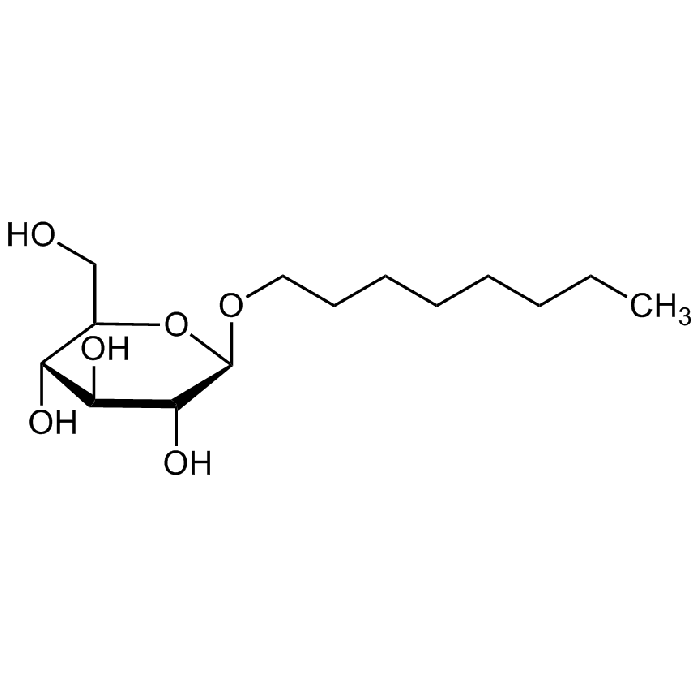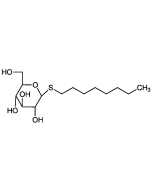Cookie Policy: This site uses cookies to improve your experience. You can find out more about our use of cookies in our Privacy Policy. By continuing to browse this site you agree to our use of cookies.
AdipoGen Life Sciences
n-Octyl-β-D-glucopyranoside (ultrapure)
As low as
50
CHF
CHF 50.00
In stock
Only %1 left
AG-CC1-0008-G0011 gCHF 50.00
AG-CC1-0008-G0055 gCHF 200.00
AG-CC1-0008-G02525 gCHF 650.00

| Product Details | |
|---|---|
| Synonyms | OG; n-Octylglucoside; n-Octyl-β-D-glucoside; BTB11967 |
| Product Type | Chemical |
| Properties | |
| Formula |
C14H28O6 |
| MW | 292.4 |
| CAS | 29836-26-8 |
| Purity Chemicals |
≥99%(HPLC) [α-Isomer <2% (NMR)] [n-Octanol: <0.005%] |
| Appearance | White powder. |
| Solubility | Soluble in water (100 mg/ml), DMSO or DMF. |
| Identity | Determined by 1H-NMR |
| InChi Key | HEGSGKPQLMEBJL-UHFFFAOYSA-N |
| Smiles | OCC1[C@@H](O)C(O)[C@H](O)[C@H](OCCCCCCCC)O1 |
| Shipping and Handling | |
| Shipping | AMBIENT |
| Short Term Storage | +4°C |
| Long Term Storage | -20°C |
| Handling Advice |
Hygroscopic. Protect from light and moisture. |
| Use/Stability | Stable for at least 3 years after receipt when stored at -20°C. |
| Documents | |
| MSDS |
 Download PDF Download PDF |
| Product Specification Sheet | |
| Datasheet |
 Download PDF Download PDF |
Description
- Non-ionic detergent for the functional solubilization, isolation, purification and crystallograpy of membrane proteins.
- Mild, non-
denaturing detergent that is used for the solubilization and reconstitution of membrane- bound proteins in their native state and for the preparation of lipid vesicles. - Its well-defined chemical structure, small uniform micelles and high water solubility make it superior to most other non-ionic detergents for membrane solubilization. The high critical micelle concentration (0.7%) of n-
octylglucoside facilitates ready removal from final protein extracts by dialysis or gel filtration. - Used in lysis and solubilisation buffers for bacterial lipoprotein preparations, mitochondrial extracts or for determination of protein content by BCA assay.
- Can be used in 2D electrophoresis and to improve selectivity of immunoprecipitation of phosphotyrosine modified proteins and to increase the resolution of proteins in 2D gels.
Product References
- Effects of octyl beta-glucoside on insulin binding to solubilized membrane receptors: R.J. Gould, et al.; Biochemistry 20, 6776 (1981)
- Reconstitution of Membrane Receptor Systems: A. Levitzki; Biochim. Biophys. Acta 822, 127 (1985)
- Micellar Properties of Octylglucoside in Aqueous Solutions: K. Kameyama, et al.; J. Colloid Interface Sci. 137, 1 (1990)
- Reconstitution of the sarcoplasmic reticulum Ca(2+)-ATPase: mechanisms of membrane protein insertion into liposomes during reconstitution procedures involving the use of detergents: D. Levy, et al.; Biochim. Biophys. Acta 1107, 283 (1992)
- Molecular dynamics characterization of n-octyl-beta-D-glucopyranoside micelle structure in aqueous solution: P. Konidala, et al.; J. Mol. Graph. Model 25, 77 (2006)
- Use of detergents to increase selectivity of immunoprecipitation of tyrosine phosphorylated peptides prior to identification by MALDI quadrupole-
TOF MS: G. Zhan & T.A. Neubert; Proteomics 6, 571 (2006) - Development and crystallization of a minimal thermostabilised G protein-coupled receptor: T. Warne, et al.; Protein Expr. Purif. 65, 204 (2009)
- Mass spectrometry of intact membrane protein complexes: A. Laganowsky, et al.; Nat. Protocols 8, 639 (2013)
- Low-Resolution Structure of Detergent-Solubilized Membrane Proteins from Small-Angle Scattering Data: A. Koutsioubas; Biophys. J. 113, 2373 (2017)








